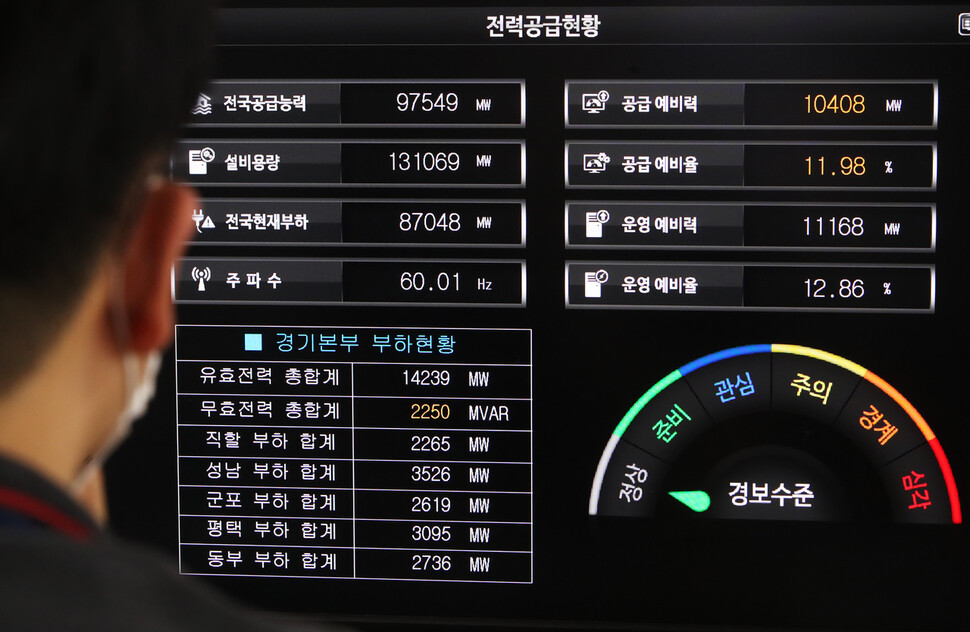[News Focus] Heatwave brings reality check for Korea’s power supply
Rush to retire nuclear reactors and switch to renewables leaves nation more vulnerable to power crisis
By Kim Byung-wookPublished : July 23, 2021 - 19:06

South Korea has reactivated three nuclear reactors in the space of a week, as fears of a power supply shortage gripped the nation amid a smothering early-summer heat wave.
At 1:10 a.m. on Friday, Korea Hydro & Nuclear Power restarted operations of the 700-megawatt Wolsong No.3 nuclear reactor, the third switched on since July 18.
It followed Shin Wolsong No. 1 and Shin Kori No.4 which went back online earlier than scheduled amid tight power supplies. All three had been closed for maintenance. They added an additional 2.15GW to the nation’s peak-hour power generation.
Despite the back-up, the nation’s electricity margin on Friday fell to 10.08 percent, just above 10 percent, an important threshold for grid operators for stable power management. It was 1.02 percentage points lower than the previous day’s low.
According to the Korea Power Exchange, as of 16:55 p.m. on Friday, the country’s electricity consumption peaked at 90.4GW against the total supply capacity of 99.5GW. That put the remaining capacity at 9.1GW.
When the remaining electricity falls below 5.5GW, a warning is issued and the authorities can mobilize emergency measures, which could include power rationing, to avert a blackout. Simply put, Korea on Friday was 3.6GW short from a power crisis.
What worries many here is that the peak summer heat hasn’t arrived yet. They fear a recurrence of a 2011 September blackout, when the electricity reserve plummeted to 3.34GW and the electricity margin dropped to 5 percent as unusually hot weather in autumn drove up electricity demand suddenly. Power was cut off from 7.5 million households and businesses recorded 6.2 billion won ($5.43 million) in losses as their factories were shut down.
The current precarious power situation is a result of several factors, experts say, from the heat wave to the local economy roaring back from the pandemic impact and the resurgence of COVID-19 forcing people to work or study from home with their home AC on.
But more fundamentally, the government has failed to manage the country’s power system to readily and efficiently respond to such a spike in demand, while it hurried to shift away from nuclear power and toward clean energy, industry watchers say.
According to an announcement made by the 9th Basic Plan for Electricity Supply and Demand in December, the government predicted the electricity demand this summer would reach a maximum 90GW.
By July 22, demand had already reached 89.9GW. The Energy Ministry estimates that demand will reach 94.4GW in the second week of August.
Last July, peak demand reached 75.6GW out of total supply capacity of 97.3GW, which put the electricity margin at 29 percent -- well above the recommended 10 percent threshold.
As the government turns to nuclear reactors due to high demand, its nuclear phase-out policy is being questioned as well.
Korea aims to downsize the capacity of its nuclear power system from last year’s 23.3GW to 19.4GW by 2034 by shutting down 11 aging reactors and fill the gap with renewables by increasing their capacity from 20.1GW to 77.8GW in the same period.
Experts have expressed concerns that replacing nuclear power, which is operational 24/7, with highly intermittent renewables such as solar and wind power can undermine the nation’s ability to swiftly respond to unexpected electricity demand surges.
Korea’s current solar and wind power capacities stand at 16 GW and 1.6 GW, respectively. During peak hours when electricity demand spikes, solar and wind power can exert only 13.9 percent and 3.1 percent of their original capacities, according to government calculations.
Simply put, solar and wind power sources would generate 2.2 GW and 0.05 GW worth of electricity and would be able to contribute just 2.4 percent of the peak power demand of 90.4 GW projected on Friday.
But according to Rep. Yoon Young-seok of the main opposition People Power Party, solar and wind power generated just 1.4 percent and 0.3 percent of electricity supply during peak hours in the July 1-15 period, while coal, liquefied natural gas and nuclear power accounted for 38.1 percent, 34.2 percent and 21.2 percent, respectively.
As part of his Green New Deal initiative, President Moon has provided incentives for solar and wind power. The number of solar farms increased from 25,421 in 2017 to 91,017 as of last month. Korea is currently building the world’s largest 8.2-GW offshore wind farm worth 48.5 trillion won set for completion by 2030.
“The government continues to pursue renewable energy with a focus on the environment and public acceptance,” an Energy Ministry official said.
To curb electricity demand, the government has ordered public agencies in different regions to take turns turning off their air conditioners between 2 p.m. and 5 p.m.







![[KH Explains] Hyundai's full hybrid edge to pay off amid slow transition to pure EVs](http://res.heraldm.com/phpwas/restmb_idxmake.php?idx=644&simg=/content/image/2024/04/18/20240418050645_0.jpg&u=20240419100350)






![[From the Scene] Monks, Buddhists hail return of remains of Buddhas](http://res.heraldm.com/phpwas/restmb_idxmake.php?idx=652&simg=/content/image/2024/04/19/20240419050617_0.jpg&u=20240419175937)

![[KH Explains] Hyundai's full hybrid edge to pay off amid slow transition to pure EVs](http://res.heraldm.com/phpwas/restmb_idxmake.php?idx=652&simg=/content/image/2024/04/18/20240418050645_0.jpg&u=20240419100350)

![[Today’s K-pop] Illit drops debut single remix](http://res.heraldm.com/phpwas/restmb_idxmake.php?idx=642&simg=/content/image/2024/04/19/20240419050612_0.jpg&u=)